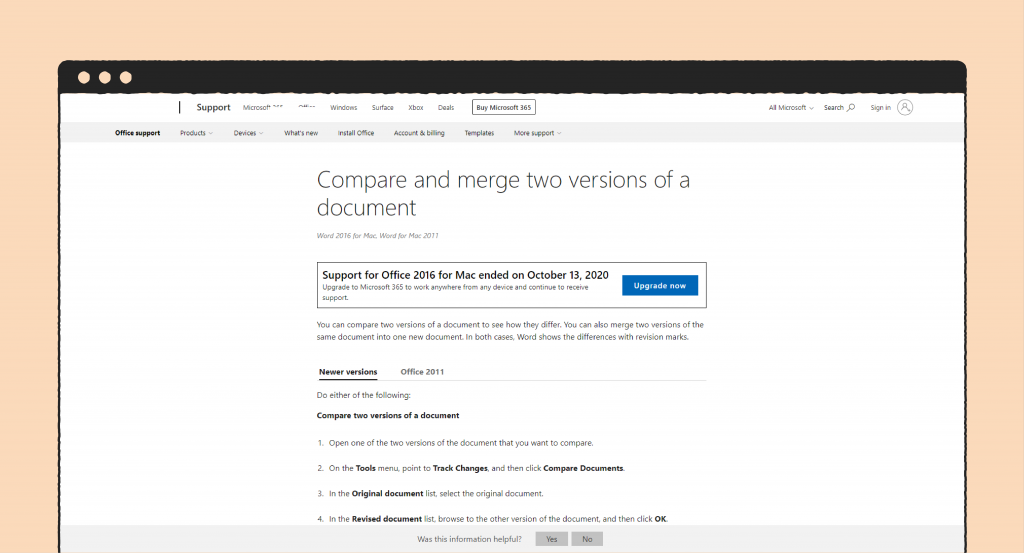
The term “redlining” (sometimes called blacklining) commonly refers to the editing and negotiation process during document and business contract management where contributors mark text and track changes collaboratively.
As part of the redlining process, one party receives the document and makes additions or annotations, and the redlined text will appear in a special color so the other party (or parties) can easily track changes without needing to spend time searching for modifications.
Track changes of entire contracts
Modern redline/blackline solutions use two separate but similar electronic input files to compare one full document against the other. This is often done with an original document when comparing it to a changed or altered document.
For example, if you load two versions of a Microsoft Word document into the software using the Compare Tool, you can see all the changes that were made inside the document.

With a cloud-based software like Google Docs, you can also use the Compare Documents tool to load in multiple versions of a document and compare those differences. As with MS Word, you’ll still need to review highlighted changes manually and determine the best way forward.
By comparing the largest pieces of text to determine where overlap occurs, the software then creates a new redlined document that highlights any discrepancies or modified or added text.
Different solutions may use different colors and conventions for indicating the modifications which may have occurred in previous versions.
The new or altered text might be underlined, double-underlined, bolded, enclosed in brackets, etc., while text that has been removed from the document is indicated via a strikethrough or a similar indication.
When should you redline?
Document redlining is well-suited when two or more people need a diplomatic approach to collaborate on the review, negotiation and/or drafting of a document or contract.
During the early stages of the contract management lifecycle, contract negotiations will typically involve some form of redlining as each party scrutinizes legal terms and business terms to agree on the contract provisions.
Similarly, decision-makers and project stakeholders higher up the chain of command may use redlining as a way of indicating desired changes before a contract moves forward.
Redlining software can help you avoid using red pens to create strikethrough text and other stray marks that then have to be deciphered by opposing counsel before a counteroffer can be made.
Common redlining challenges
Redlining is a complicated, logistical back-and-forth process and, as such, features a number of common challenges and difficulties that collaborators might face.
While tackling these issues, remember: Legal counsel can help you to understand and identify elements that may have been left out of legal documents, contracts, or a negotiation discussion.
1. Untracked changes
Any changes to any portion of the entire contract must be tracked within the document.
Forgetting to enable the track changes feature before revisions begin can break the redlining document comparison process, potentially losing changes and making them difficult for external parties to identify.
2. Reading difficulties
One of the most common problems from redlining is that documents can become hard to read as the number of changes increases.
Without clean copy, spelling mistakes and minor formatting errors can become easy to overlook.
3. Broken formatting
Accepting the changes a previous collaborator has proposed to the document may strip the intended formatting from portions of your document. When this happens, it becomes necessary to reformat the document to the desired layout.
Additionally, sharing documents for redlining between different software solutions can result in lost or broken formatting, as the formatting options in one piece of software might not align with the options in another.
4. Residual metadata
Tracking document changes with a redlining tool can frequently result in the creation of undesired metadata, which may contain sensitive or personal information.
This makes it necessary to remove all metadata before sending the document to another recipient or collaborator.
5. Mobile compatibility
Not all redlining software functions across multiple platforms, making sharing documents for redlining between desktop computers and devices like tablets fairly hit-or-miss.
How to redline effectively and efficiently
At its core, redlining is a process designed to eliminate the need for lengthy alignment meetings. Automatically tracking changes ensures that collaborators can quickly identify opportunities that require conversations and work to resolve them, thus saving time in the contracting process.
To ensure that you’re redlining efficiently, consider the following steps for how best to modify your document:
Get everyone on the same page
Before you even begin redlining, make sure that both parties know who will contribute to the document.
Get on the same page and align around a shared vision. Documents pertaining to transactions, such as contracts and agreements, have a different focus than things like employment documentation.
For best results, take the time to understand what you’re redlining and with whom you’re sharing document ownership.
Don’t rush the process
Ensure that all of the details are in order and unimpeachable before the signing process begins.
If you’re using a word processing software like MS Word, make sure to check your review tab one last time. Be sure to accept all changes before moving forward.
If someone needs to make a change halfway through the signing process, you’ll have to start the entire process over again.
Keep in mind that a signed document later discovered to have an overlooked error due to human error or miscommunication is still legally binding.
Stay compliant
When creating a legally binding document your first priority should be its adherence to legal and functional standards. Be absolutely certain that the language you use is legally compliant.
Most document and contract clauses can be set up with standardized or boilerplate language, which makes tracking any deviation from the norm much simpler.
Track every change
You need to be absolutely certain that all changes made to the document are tracked and preserved throughout the whole process.
Do not leave anything to chance when creating documents that could have a binding impact on your business operations.
Make sure that every change is recorded and that both parties agree to any deviations or deletions from your standard contract templates.
Provide different versions of your document
Offer your collaborator the tools to efficiently perform their own redlining processes by giving them three versions of your document.
This includes each of the following:
- A redlined version (to track your changes)
- An unmarked version (for ease of reading)
- A clean version ready for redline markups and feedback
When providing these documents, be sure to provide clarity on the use case for each document in order to prevent confusion.
Know your software and its limitations
Not all redlining software is created equal, and software that is not cloud-based can come with a unique number of special challenges.
For instance, while Microsoft Word has redlining and track change capabilities, it does not automatically track the changes made to documents by multiple parties.
Instead, you’ll need to email files back and forth between collaborators while ensuring that all tracked changes are consolidated into a single document. This can get tricky, especially if you’re working with multiple users.
You’ll also need to ensure that any residual metadata is stripped out before you send the document back out for another round of edits.
Redlining features deliver value
Redlining contracts is an essential part of the contract process for a variety of industries.
More professional and timely documents have fewer mistakes and make prospects more likely to sign. When your clients get specified contracts, you get less back and forth editing.
PandaDoc supplies everything you need from one platform for the entire contract automation and redlining process.
And you aren’t the only ones taking advantage of PandaDoc storage capabilities:
- In just one quarter, an office concierge service was able to decrease their time to close by 15% and save over $100,000 in annual software costs.
- A construction management company was able to boost productivity and 3x the number of closed deals.
- A marketing automation company was able to save $5k in legal fees and decrease their sales cycle by 75%.
- An event management company increased sales prices 10% across the board and increased sales close rates by 32%.
From SaaS and security consulting firms to creative teams and construction management companies, PandaDoc helps organizations eliminate wasted staff hours and legal resources on painful and elongated contracting processes.
These organizations trust PandaDoc to expedite their redlining processes and help them close deals even faster.
Give PandaDoc a try by signing up for a free 14-day trial.
Originally published August 19, 2019, updated May 31, 2021
Looking For Document Management System?
Call Pursho @ 0731-6725516
Check PURSHO WRYTES Automatic Content Generator
https://wrytes.purshology.com/home
Telegram Group One Must Follow :
For Startups: https://t.me/daily_business_reads




